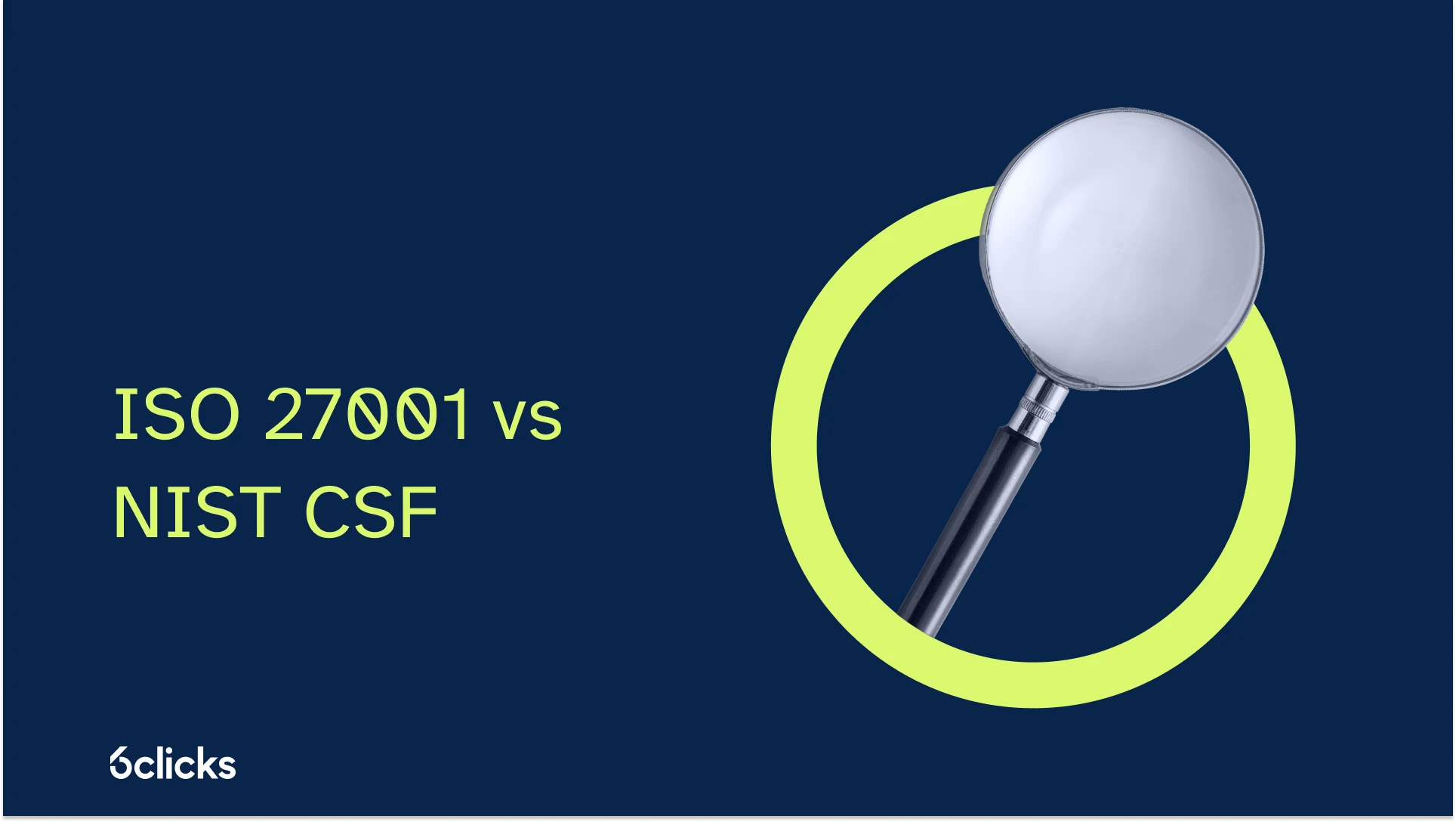Key Takeaways
-
The NIST CSF (Cybersecurity Framework) and ISO 27001 are two prominent frameworks that help organizations establish effective cybersecurity controls and manage cybersecurity risks.
-
The NIST CSF provides a flexible and adaptable approach, with five core functions: Identify, Protect, Detect, Respond, and Recover. It allows organizations to create custom cybersecurity profiles and assess their cybersecurity maturity level using implementation tiers.
-
ISO 27001 is a globally acknowledged standard for establishing an Information Security Management System (ISMS) and managing information security risks comprehensively. It includes a set of controls divided into 14 categories.
-
While both frameworks contribute to a strong cybersecurity posture, they have distinct differences. The NIST CSF is voluntary and self-assessed, while ISO 27001 requires external certification audits. The NIST CSF is more flexible and adaptable, while ISO 27001 provides a standardized approach. ISO 27001 has higher international recognition, but both frameworks offer benefits in enhancing cybersecurity.
In today's rapidly evolving digital landscape, organizations face increasing cybersecurity risks that can compromise the confidentiality, integrity, and availability of their information assets. To address these challenges and establish a robust cybersecurity program, frameworks and standards have been developed to guide organizations in implementing effective cybersecurity controls. Two prominent frameworks in this regard are the NIST Cybersecurity Framework CSF (NIST CSF) and ISO 27001 (Information Security Management System).
The NIST CSF, developed by the National Institute of Standards and Technology, offers a flexible and adaptable approach to managing cybersecurity risks and implementing cybersecurity controls. It provides a roadmap consisting of five core functions: Identify, Protect, Detect, Respond, and Recover. This framework assists organizations in identifying and assessing their cybersecurity risks, establishing protective measures, detecting and responding to cybersecurity events, and recovering from potential disruptions. By following the NIST CSF, organizations can develop a comprehensive cybersecurity program that aligns with industry best practices.
On the other hand, ISO 27001 is a globally acknowledged standard for the establishment and upkeep of an Information Security Management System (ISMS), which includes the implementation of robust cybersecurity controls. The standard focuses on comprehensive information security management, risk assessment, and control implementation. By adopting ISO 27001, organizations can establish an effective ISMS that encompasses various cybersecurity controls, such as access control, incident management, encryption, network security, and more. This enables organizations to establish a structured approach to cybersecurity and ensure the confidentiality, integrity, and availability of their information assets.
In this blog, we will delve into the details of both frameworks by exploring their key components, certification processes, benefits, and the key differences in their focus and purpose. Additionally, we will examine the compliance process, time, and cost associated with achieving certification for each framework. By understanding the nuances of these frameworks and incorporating them into their cybersecurity program, organizations can make informed decisions to enhance their cybersecurity posture, implement effective cybersecurity controls, and protect their critical assets from emerging threats.
The NIST CSF (Cybersecurity Framework)
Developed by the National Institute of Standards and Technology (NIST), the NIST CSF (Cybersecurity Framework) is a voluntary and adaptable framework designed to manage and mitigate cybersecurity risks. While initially intended for critical infrastructure organizations, the CSF's flexible nature allows it to be implemented by non-US and non-critical infrastructure organizations as well. The NIST CSF is a dynamic framework that remains ever-evolving to meet the evolving demands of the industry. It undergoes continuous updates and refinements, ensuring its relevance and effectiveness in addressing the ever-changing cybersecurity landscape. By staying current with emerging threats and industry trends, the NIST CSF equips organizations with the necessary tools to proactively manage cybersecurity risks and protect their critical assets. Its agile nature enables organizations to stay ahead of potential vulnerabilities and make informed decisions in an ever-evolving digital environment.
The NIST CSF consists of five core functions:
-
Identify: This function involves understanding the organization's business context, establishing governance, and conducting risk assessments to identify cybersecurity risks and dependencies.
-
Protect: The protect function focuses on implementing safeguards to protect against potential threats. It includes activities such as access controls, data encryption, and security awareness training.
-
Detect: The detect function involves implementing monitoring and detection systems to identify cybersecurity events and potential incidents. It includes activities such as log analysis, security incident detection, and continuous monitoring.
-
Respond: The respond function focuses on developing and implementing an effective incident response plan. It includes activities such as incident handling, communication, and coordination with relevant stakeholders.
-
Recover: The recover function involves restoring systems and services to their normal state after a cybersecurity incident. It includes activities such as system recovery, data backups, and lessons learned.
Additionally, the NIST CSF allows organizations to create custom cybersecurity Profiles. Profiles serve as specific roadmaps tailored to an organization's unique requirements, considering factors such as business objectives, regulatory compliance, and risk tolerance. These Profiles help organizations prioritize and align their cybersecurity efforts to address their specific needs and challenges effectively.
Furthermore, the NIST CSF emphasizes the importance of understanding an organization's risk tolerance. Risk tolerance refers to an organization's willingness to accept certain levels of risk while pursuing its business objectives. The NIST CSF enables organizations to establish risk management processes that reflect their risk tolerance levels. By assessing their risk tolerance and aligning it with the identified cybersecurity risks, organizations can make informed decisions regarding resource allocation, risk mitigation strategies, and cybersecurity investments.
In addition to Profiles and Risk Tolerance, the NIST CSF offers Implementation Tiers, which provide organizations with a structured approach to assess their current cybersecurity practices and establish a target state. The Implementation Tiers consist of the following levels:
-
Tier 1 - Partial: Organizations at this tier have limited awareness of cybersecurity risks and lack a formalized approach to cybersecurity management.
-
Tier 2 - Risk Informed: Organizations at this tier have an awareness of cybersecurity risks and are starting to establish risk management processes.
-
Tier 3 - Repeatable: Organizations at this tier have implemented defined cybersecurity processes and practices that are consistently applied across the organization.
-
Tier 4 - Adaptive: Organizations at this tier have an agile and dynamic cybersecurity program that proactively adapts to evolving threats and incorporates lessons learned.
By using the Implementation Tiers, organizations can assess their current cybersecurity maturity level and set targets for improvement, gradually progressing towards a higher tier. This structured approach enables organizations to align their cybersecurity practices with their desired risk management goals and enhance their overall cybersecurity posture.
ISO 27001 (Information Security Management System)
ISO 27001 is a universally acknowledged benchmark for developing and upholding an exceptional Information Security Management System (ISMS). The standard provides a comprehensive framework for managing information security risks, ensuring the confidentiality, integrity, and availability of information assets.
ISO 27001 consists of a set of controls that organizations can implement to manage information security risks effectively. These controls are divided into 14 categories, as outlined in Annex A of the standard. Here is a breakdown of these control categories:
-
Information Security Policies: This category includes controls related to the development, implementation, and maintenance of information security policies, procedures, and guidelines within the organization.
-
Organization of Information Security: Controls in this category focus on establishing the management framework for information security, including defining roles and responsibilities, managing resources, and promoting awareness and training.
-
Human Resource Security: These controls address the security aspects related to employees, contractors, and third-party personnel, such as background checks, employment agreements, and security awareness training.
-
Asset Management: Controls in this category cover the identification, classification, and management of information assets, including their ownership, acceptable use, handling, and disposal.
-
Access Control: Controls under this category aim to ensure that access to information and information processing facilities is authorized, controlled, and monitored, including user access management, user responsibilities, and network access control.
-
Cryptography: This category focuses on controls related to the use of cryptographic mechanisms to protect the confidentiality, integrity, and authenticity of information.
-
Physical and Environmental Security: Controls in this category address the physical protection of information assets, including secure areas, equipment protection, and secure disposal of media.
-
Operations Security: Controls under this category pertain to the secure management of day-to-day operations, such as operational procedures and responsibilities, protection against malware, and backup and recovery.
-
Communications Security: These controls cover the security aspects of network and information exchange, including network security management, information transfer, and electronic messaging.
-
System Acquisition, Development, and Maintenance: Controls in this category focus on ensuring that information security is incorporated throughout the systems development lifecycle, including requirements analysis, secure system engineering, and system change control.
-
Supplier Relationships: Controls under this category address the security considerations when dealing with external suppliers, including supplier selection, agreements, and monitoring.
-
Information Security Incident Management: This category includes controls related to the identification, reporting, and handling of information security incidents, including incident response planning, communication, and learning from incidents.
-
Information Security Continuity: Controls in this category aim to establish plans and procedures for maintaining information security continuity in the event of a disruption, including business continuity management, backup, and recovery.
-
Compliance: Controls under this category focus on ensuring compliance with legal, regulatory, and contractual requirements, including intellectual property rights, protection of records, and data protection.
ISO 27001 provides a comprehensive approach to managing information security risks. It focuses on establishing an ISMS that encompasses all aspects of an organization's information security, including policies, procedures, and controls. By aligning with ISO 27001, organizations can demonstrate their commitment to protecting sensitive information, comply with legal and regulatory requirements, and enhance their overall information security management practices.
The NIST CSF compliance process
The NIST Cybersecurity Framework (CSF) provides a flexible and customizable approach to managing cybersecurity risks and consists of five core functions: Identify, Protect, Detect, Respond, and Recover.
-
Identify: This function involves understanding the organization's business context, establishing governance, and conducting risk assessments to identify cybersecurity risks and dependencies.
-
Protect: The protect function focuses on implementing safeguards to protect against potential threats. It includes activities such as access controls, data encryption, and security awareness training.
-
Detect: The detect function involves implementing monitoring and detection systems to identify cybersecurity events and potential incidents. It includes activities such as log analysis, security incident detection, and continuous monitoring.
-
Respond: The respond function focuses on developing and implementing an effective incident response plan. It includes activities such as incident handling, communication, and coordination with relevant stakeholders.
-
Recover: The recover function involves restoring systems and services to their normal state after a cybersecurity incident. It includes activities such as system recovery, data backups, and lessons learned.
The NIST CSF provides companies with a roadmap to assess and improve their cybersecurity posture. It allows companies to align their security practices with industry standards and best practices.
Benefits of NIST CSF compliance
While you can't be NIST certified, achieving NIST CSF compliance offers several benefits to organizations:
-
Enhanced Cybersecurity: Implementing the NIST CSF helps organizations improve their overall cybersecurity posture by identifying and mitigating risks effectively.
-
Risk Management: The framework provides a systematic approach to managing cybersecurity risks, allowing organizations to prioritize and allocate resources accordingly.
-
Industry Recognition: NIST CSF certification demonstrates an organization's commitment to cybersecurity best practices, which can enhance its reputation and build trust with stakeholders.
-
Regulatory Compliance: Compliance with the NIST CSF can help organizations meet regulatory requirements, especially for critical infrastructure sectors.
The ISO 27001 certification process
ISO 27001 provides a comprehensive framework for establishing, implementing, maintaining, and continually improving an organization's information security management.
The ISO 27001 certification process typically involves the following steps:
-
Gap Analysis: The organization assesses its current security controls and practices against the requirements of ISO 27001 to identify any gaps and areas for improvement.
-
Risk Assessment: The organization conducts a systematic assessment of its information assets, threats, vulnerabilities, and associated risks to determine the necessary security controls.
-
Documentation and Implementation: The organization develops and implements policies, procedures, and controls based on the requirements of ISO 27001.
-
Internal Audit: The organization conducts internal audits to assess the effectiveness and compliance of its information security management system.
-
Certification Audit: An independent certification body performs an audit to evaluate the organization's compliance with ISO 27001. If the organization meets the requirements, it is awarded ISO 27001 certification.
Benefits of ISO 27001 Certification
Obtaining ISO 27001 certification offers several benefits to organizations:
-
Comprehensive Information Security Management: ISO 27001 provides a holistic framework for managing information security risks, ensuring the confidentiality, integrity, and availability of information assets.
-
Risk-Based Approach: The standard emphasizes a risk-based approach, enabling organizations to prioritize and allocate resources based on identified risks.
-
Legal and Regulatory Compliance: ISO 27001 helps organizations meet legal, regulatory, and contractual requirements related to information security.
-
Competitive Advantage: ISO 27001 certification demonstrates an organization's commitment to protecting sensitive information, which can provide a competitive edge in the marketplace.
What's the Difference?
The renowned frameworks of NIST CSF and ISO 27001 empower organizations with best practices for a robust cybersecurity posture, distinguishing them as premier choices in enhancing digital resilience. They share a common goal of enabling organizations to identify, track, mitigate, prepare for, and recover from security incidents and data breaches, instilling customer trust and confidence.
However, it's important to note that these frameworks are not interchangeable. While they both contribute to a strong security posture, they have distinct differences that organizations should be aware of. In this section, we will explore and delve into the key differences between the NIST CSF and ISO 27001 frameworks. Understanding these differences will help organizations make informed decisions about which framework aligns best with their specific needs and objectives.
Focus and purpose
The key differences between the NIST CSF and ISO 27001 lie in their focus and purpose.
Crafted as a voluntary framework by the National Institute of Standards and Technology, the NIST CSF (Cybersecurity Framework) takes center stage in managing cybersecurity risks, placing special focus on bolstering the resilience of critical infrastructure organizations. It provides a set of best practices, standards, and guidelines for organizations to manage and mitigate cybersecurity risks.
On the other hand, ISO 27001 is an internationally recognized standard for establishing and maintaining an Information Security Management System (ISMS). Its focus is on managing information security risks comprehensively across all aspects of an organization's information security, including policies, procedures, and controls.
Compliance process
The compliance process for the NIST CSF and ISO 27001 frameworks differs in their approach to certification and audits.
NIST CSF does not offer formal certifications. Organizations using the NIST CSF framework conduct self-assessments to determine their compliance with the framework's guidelines. The framework allows organizations to build a robust program and demonstrate their adherence to best practices without undergoing external certification audits.
ISO 27001, on the other hand, requires organizations to undergo a certification process conducted by external auditors. This process involves a thorough assessment of the organization's ISMS to ensure compliance with the ISO 27001 standard. Certification is valid for three years and involves regular surveillance and recertification audits to maintain compliance.
Flexibility and adaptability
The NIST CSF is designed to be flexible and adaptable to different organizations, regardless of their size or industry. It offers a customizable framework that can be tailored to an organization's specific cybersecurity needs and risk profiles.
ISO 27001 provides a structured and standardized approach to managing information security risks. While it allows organizations to adapt the implementation of controls based on their specific requirements, it follows a more rigid framework that provides a consistent structure for organizations to establish and maintain their ISMS.
International recognition
ISO 27001 is an internationally recognized standard widely adopted by organizations worldwide. Achieving ISO 27001 certification signifies that an organization has implemented robust information security practices aligned with globally accepted standards. This recognition can enhance the organization's reputation and credibility in the international market.
The NIST CSF, although originating from the United States, has gained recognition and adoption beyond its intended audience. While it may not carry the same level of international recognition as ISO 27001, it still serves as a valuable framework for organizations seeking to improve their cybersecurity posture.
Cost and resource implications
The cost and resource implications vary between the NIST CSF and ISO 27001 frameworks.
Implementing the NIST CSF is relatively cost-effective as the framework itself is freely available. However, organizations need to allocate resources for internal assessments, implementation of controls, and ongoing monitoring of cybersecurity practices.
ISO 27001 certification involves costs associated with purchasing the standard, conducting gap analyses and risk assessments, implementing policies and controls, engaging external auditors for certification audits, and maintaining the ISMS. The certification process requires a significant investment of financial and human resources.
So, which one is better?
The selection between the NIST framework and ISO 27001 for an organization depends on various factors, including the business's maturity, budgetary constraints, and stakeholder requirements.
Organizational maturity and budget
If your business is new or in its early stages, or if you have limited resources and budget allocated to cybersecurity, the NIST framework can be a valuable starting point. The NIST Cybersecurity Framework (CSF) provides a flexible and scalable approach to managing cybersecurity risks. It offers a set of best practices and guidelines that can be tailored to meet the specific needs and resources of your organization, allowing you to establish foundational cybersecurity controls and practices without significant financial investment.
On the other hand, if your organization has scaled up, has matured its cybersecurity practices, or has allocated a substantial budget to cybersecurity, implementing ISO 27001 may be a more suitable choice. It provides a comprehensive framework for managing information security risks and establishes a systematic approach to protect sensitive information assets. While implementing ISO 27001 may require a higher upfront investment in terms of time, resources, and costs, it offers a robust and widely recognized certification that can enhance your organization's credibility and reputation.
Stakeholder requirements
Demonstrating a certificate or compliance with a recognized cybersecurity standard can be valuable when pitching to potential clients or retaining existing ones. ISO 27001 certification, achieved through a formal audit process, can provide a level of assurance to stakeholders that your organization has implemented robust information security controls. This can be particularly important if your business operates in industries or sectors where security and compliance requirements are stringent, such as finance, healthcare, or government.
While the NIST framework does not offer a formal certification process, it can still be used to showcase your organization's commitment to cybersecurity. By aligning your cybersecurity practices with the NIST CSF and implementing its recommended controls, you can demonstrate to stakeholders that you have adopted a recognized and industry-standard approach to managing cybersecurity risks.
In summary, the choice between the NIST framework and ISO 27001 depends on your organization's maturity, budget, and stakeholder requirements. The NIST framework is suitable for organizations starting out or with limited resources, allowing them to establish foundational cybersecurity practices. ISO 27001 is preferable for organizations with mature cybersecurity practices, sufficient budget, and a need for formal certification to demonstrate their commitment to information security.
Which is best for you?
Choosing between ISO 27001 and NIST CSF depends on several factors such as regulatory requirements, industry standards, customer expectations, and organizational goals. ISO 27001 is recognized globally and is often required or preferred by international clients or partners. It provides a structured and comprehensive approach to information security management, ensuring compliance with legal, regulatory, and contractual obligations.
On the other hand, NIST CSF is particularly beneficial for organizations operating within the United States or those seeking to align with U.S. government standards. It offers a more adaptable and risk-based approach, allowing organizations to prioritize their cybersecurity efforts based on their specific needs and circumstances. NIST CSF also provides valuable guidance for incident response and recovery, enhancing an organization's ability to handle and mitigate cyber threats effectively.
Ultimately, the choice between ISO 27001 and NIST CSF depends on the context and requirements of your company. Some organizations may opt for ISO 27001 for its international recognition and comprehensive approach, while others may prefer NIST CSF for its flexibility and alignment with U.S. standards. It is essential to carefully assess your organization's unique needs, evaluate applicable regulations and standards, and consider the potential benefits and limitations of each framework before making a decision.
Streamline your compliance with 6clicks
As organizations strive to protect their information assets and mitigate cybersecurity risks, frameworks and standards play a crucial role in guiding their efforts. The NIST CSF and ISO 27001 offer comprehensive approaches to managing information security, albeit with different focuses and purposes.
The NIST CSF provides a flexible framework that allows organizations to identify, protect, detect, respond, and recover from cybersecurity incidents. It offers a roadmap for organizations to align their security practices with industry standards and best practices.
ISO 27001, on the other hand, focuses on establishing and maintaining an Information Security Management System (ISMS) that covers all aspects of an organization's information security. It emphasizes a risk-based approach, enabling organizations to prioritize and allocate resources based on identified risks.
Both frameworks offer significant benefits, such as enhanced cybersecurity posture, risk management, industry recognition, and regulatory compliance. Achieving certification for either framework involves a comprehensive compliance process, including gap analysis, risk assessment, documentation, internal audits, and certification audits by independent bodies.
The time and cost involved in achieving certification can vary depending on the organization's size, complexity, and existing security practices. ISO 27001 certification generally requires a significant investment of time and resources, while the NIST CSF's flexibility allows organizations to tailor its implementation to their specific needs.
By understanding the intricacies of these frameworks and considering their respective compliance processes, time, and cost factors, organizations can make informed decisions regarding which framework aligns best with their objectives and requirements. Ultimately, both the NIST CSF and ISO 27001 provide valuable guidance to organizations in establishing robust information security controls and fortifying their defenses against cybersecurity threats.
If you want to know how these ISO 27001 controls may relate to those in other frameworks like the NIST Cyber Security Framework or others, you can always get that from Hailey.
If you would like more details on how 6clicks can help you achieve ISO 27001 compliance and NIST CSF alignment, then please reach out to us below.
Written by Louis Strauss
Louis began his career in Berlin where he also founded Dobbel Berlin – Berlin’s curated search engine. Returning to Melbourne to join KPMG, Louis lead the development of software designed to distribute IP and create a platform for us by advisors and clients. While at KPMG, Louis also co-authored Chasing Digital: A Playbook for the New Economy. Louis is accomplished in stakeholder management, requirements gathering, product testing, refinement and project implementation. Louis also holds a Bachelor of Engineering and a Masters of Information Systems from the University of Melbourne.












